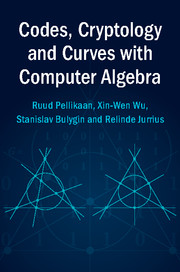Book contents
- Frontmatter
- Dedication
- Contents
- Preface
- 1 Error-correcting Codes
- 2 Code Constructions and Bounds on Codes
- 3 Weight Enumeration
- 4 Cyclic Codes
- 5 Polynomial Codes
- 6 Algebraic Decoding
- 7 Complexity and Decoding
- 8 Codes and Related Structures
- 9 Cryptology
- 10 Gröbner Bases for Coding and Cryptology
- 11 Codes on Curves
- 12 Coding and Cryptology with Computer Algebra
- References
- Index
9 - Cryptology
Published online by Cambridge University Press: 26 October 2017
- Frontmatter
- Dedication
- Contents
- Preface
- 1 Error-correcting Codes
- 2 Code Constructions and Bounds on Codes
- 3 Weight Enumeration
- 4 Cyclic Codes
- 5 Polynomial Codes
- 6 Algebraic Decoding
- 7 Complexity and Decoding
- 8 Codes and Related Structures
- 9 Cryptology
- 10 Gröbner Bases for Coding and Cryptology
- 11 Codes on Curves
- 12 Coding and Cryptology with Computer Algebra
- References
- Index
Summary
This chapter provides a brief overview of selected topics in the exciting field of cryptology. In particular, we cover symmetric and asymmetric encryption cryptosystems. When talking about symmetric cryptography, we deal with the notion of a block cipher as one of the main cryptographic primitives, i.e. building blocks, for modern practical applications. Asymmetric cryptography is illustrated by the RSA and El Gamal encryption cryptosystems. Later, we present code-based cryptosystems due to McEliece and Niederreiter. In this chapter we will use the terms “cryptosystem” and “encryption schemes” as synonyms for simplicity. These schemes are good examples for a connection between the theory of error-correcting codes and cryptography. Whereas in the theory of error-correcting codes one deals with correcting errors in noisy channels, in the cryptographic applications a crypto designer intentionally adds noise to confuse an attacker and only a legitimate counterpart can remove the noise from a transmitted message.
We also take a look at other interesting topics such as authentication codes, secret sharing, and linear feedback shift registers. Here, we especially discuss connections to codes and related structures. Therewith we show how error-correcting codes can be used in other parts of cryptography as well.
Symmetric Encryption Schemes and Block Ciphers
Symmetric Encryption Schemes
This section is devoted to symmetric cryptosystems, symmetric encryption schemes to be more precise. The idea behind these is quite simple and thus has been known for ages. The problem to be addressed is to convey a secret message between two parties, called traditionally Alice and Bob, so that figuring out the secret message is not possible without knowledge of some additional information. This additional information is called a secret key and is supposed to be known only to the two communicating parties. The secrecy of the transmitted message rests entirely upon the knowledge of this secret key, and thus if an adversary or an eavesdropper, traditionally called Eve, is able to find out the key, then the whole secret communication is corrupted. Now let us take a look at the formal definition.
Information
- Type
- Chapter
- Information
- Codes, Cryptology and Curves with Computer Algebra , pp. 368 - 429Publisher: Cambridge University PressPrint publication year: 2017
